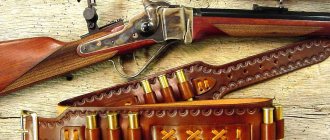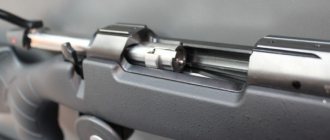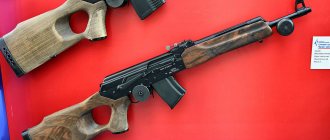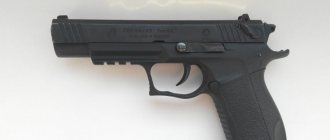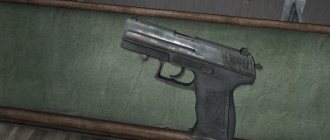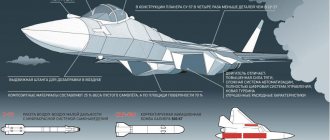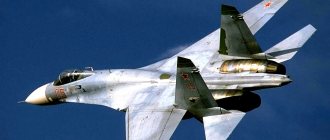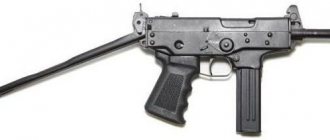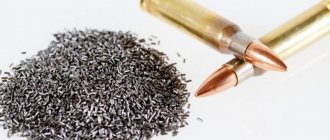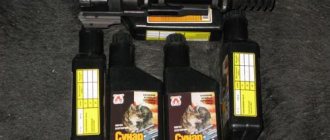Sokol gunpowder is the oldest of the domestic smokeless gunpowders, produced since 1937. In 1977, in connection with the release of a new state standard for smokeless powder, both the composition of the gunpowder and its quality characteristics were changed.
Although there are a large number of more modern gunpowders on the market these days, many of which are more effective than Sokol gunpowder, it still holds its own. Probably about 80% of the cartridges loaded by hunters are independently loaded with this gunpowder.
The Sokol is also supported by the fact that many manufacturers equip their cartridges with it, preferring it to other options due to its low cost.
About gunpowder
There are 2 types of gunpowder - smoky and smokeless. The first option is always allocated more space in the cartridge; during shooting, with its presence, clouds of smoke are formed, which often interfere with detecting the results, contribute to clogging of the barrel, it produces more recoil, and the sounds of shots become louder. Nevertheless, its shelf life is longer, and its price is lower than that of smokeless analogues. It also has less negative impact on the bores and is less sensitive to changes in charge weight.
However, at the moment it has been supplanted by the smokeless version, which is considered more advanced. Hunters use it much more often. When choosing gunpowder for 12-gauge cartridges, you need to take into account the purpose of shooting and the characteristics of the weapon. The most popular materials are 3 types of smokeless powder: “Falcon”, “Bars”, “Sunar”.
Quick Tips
In order to make maximum use of the advantages of Sokol in practice, it is necessary to follow the following recommendations:
- In addition to brass cartridges, unlike other types of smokeless powder, “Falcon” can be loaded with paper cartridges without additional inconvenience. It does not require precision mounting, which reduces the risk of the sleeve diverging at the seams and exceeding it.
- For high-quality loading of a cartridge with shot, it is necessary to strengthen the rolling.
- Using a heavy-duty primer will ensure complete combustion of the powder. This capsule has a high price, but it has the right power.
- Storing “Falcon” is unacceptable in rooms with sudden temperature changes: nitroglycerin may sweat out of the total mass. This property of gunpowder made it impossible to use it for clay pigeon shooting.
- It is not recommended to use “Falcon” in weapons that have not been tested on it, as well as in old and worn-out models.
Did you like it? Share on social networks!
We recommend reading
- Features of using the Elk carbine and its technical characteristics
- Gunpowder Sunar weights and characteristics
- Description of the characteristics and features of Irbis gunpowder
- ← How to make a hazel grouse decoy with your own hands and features of use
- Muskrat hunting – Methods and price →
"Falcon"
The most common version of the 12-gauge charge is with Sokol brand gunpowder. About 90% of self-loading cartridges are assembled using this type of important ingredient.
To understand how much gunpowder to use in 12 gauge, you need to stock up on scales whose accuracy will not exceed 0.05 g.
In this case, it will be better if the weight deviates towards a decrease from the set charge: for example, for a charge of 2.2 g of gunpowder it is better to take 2.15 g than 2.25 g. This is an important point when there is a maximum allowable weight.
To shoot shot and buckshot at an air temperature of 20 degrees using felt wads, 2.1-2.2 g of gunpowder for 12-gauge hunting cartridges is required.
The heavier the gun, the more powerful the load should be. In the lightest weapons it can be minimal. If hunting is carried out using wood-fiber wads, the weight of gunpowder in a 12-gauge cartridge increases by 0.1 g. If polyethylene wads are used with or without a concentrator, then the weight is reduced by 0.2 g compared to the norm adopted for felt wads.
When shooting is carried out at a temperature of -20 degrees, cartridges with a felt wad are chosen, and the weight of gunpowder for 12 gauge is increased by 0.1 g in comparison with its weight, which is used when shooting at an air temperature of 20 degrees with wads of the same type.
The situation changes if the shot is used for hunting small furs. Then, to load 12-gauge cartridges, there will be enough gunpowder weighing 1.1-1.2 g. The mass of the shot will be 16 g.
But it is worth considering that this requires strong rolling of the sleeves. This is achieved by increasing their depth and using glue (such as BF). The primers in this case use “Zhevelo powerful” because they speed up the combustion of gunpowder. They can use rubber or corks to make wads that are needed for semi-loaded cartridges. When firing bullets, the mass of gunpowder for 12 caliber “Falcon” is increased by 0.1 g.
Test results
The manufacturer gives very few recommendations for equipping Falcon cartridges. Quite a lot of time has passed since the development of technology, and a lot of new varieties of hunting weapons have appeared.
To determine the characteristics of the equipment of each specific option, it is necessary to test the speed of the shot and bullet for different charge weights.
The average speed of shot flight at various charge mass ratios was experimentally established:
- Charge weight 1.6 g. fraction 24 gr. — from 348 m/s to 356 m/s.
- Charge weight 2.3 g. fraction 32 gr. — from 384 m/s to 389 m/s.
When testing cartridges loaded with bullets, the charge mass remained unchanged - 2.2 g. Test speeds ranged from 362 m/s to 513 m/s. The Falcon showed the best results in a cartridge equipped with a Mayer bullet. The minimum indicator was for a cartridge with a Brenneke bullet.
The ratio of the mass of the shot and the charge
When supplying 12-gauge cartridges with Sokol gunpowder, its ratio with shot is checked experimentally. Each shooter chooses the optimal combination for himself. To do this, equip 12-gauge cartridges with Sokol gunpowder in different proportions. Start with a minimal amount of gunpowder and gradually increase its weight. It is not uncommon to use coefficients that help you choose how much 12 gauge gunpowder you need depending on the type of shooting. The hunter himself makes the final adjustments to the dosage, taking into account his feelings, lethal force and recoil of the weapon. The dosage of gunpowder in 12 gauge and the ratio with shot is calculated by the formula: C x K = P.
Here C is the weight of the shot, correlated with the mass of the gun; P is the mass of gunpowder, and K is the charge ratio coefficient.
Thus, the calculation of the weight of shot in a 12-gauge shotgun is carried out by dividing the weight of the shotgun by 94.
The coefficient value will fluctuate for gunpowder for hunting with 12 gauge in the region of 10/150 – 10/180. Based on extensive practice, it is usually 10/165. That is, the average coefficient is 16.5. The value of K greatly affects the characteristics of shooting. When it increases to 18, the shooting becomes more crowded, but less sharp. If it is reduced to 15, then the first indicator decreases, and the second increases.
Advantages and disadvantages of gunpowder
Despite the fact that Sokol gunpowder is the most popular in Russia, even an experienced hunter would hardly dare to say that the product is free of drawbacks. However, it’s worth starting the review with the positive aspects, since there are many more of them, and they sound more convincing:
- Prevalence. Sokol gunpowder is the most popular domestic product on the market. You can find it in literally any gun store. At the same time, the majority of cartridges from manufacturing plants use the Falcon for equipment and testing.
- Excellent combustion rate. Thanks to this, the weapon's combat is quite sharp and accurate . Ultimately, it is the combustion rate that determines most of the individual needs of shooters (high shot power, bullet speed and accuracy).
- Ballistic stability. Sokol gunpowder is the best product for self-loading cartridges, since it retains its properties when using different types of ballistic projectiles with different weights.
- Reasonable price. There are almost no competitors for Sokol on the Russian market (perhaps only Irbis). The reason for this lies not only in the high quality of the product, but also in the fairly low price (from 368 rubles per 250 grams).
- Does not require careful weighing. Inexperienced hunters often add a double dose of gunpowder to “roll-your-own” guns, resulting in them being left without a gun or even injured. “Falcon” forgives such mistakes if its weight is within reason.
- The shot does not deform when fired. Although not the most powerful gunpowder on the market, Sokol has another important quality - the absence of a negative effect on the projectile. This significantly increases the service life of a shotgun or rifle.
However, you should not feed yourself false hopes and assume that Sokol gunpowder is ideal. Yes, there are plenty of positive aspects, but you shouldn’t forget about the disadvantages, even if they are not as significant as the advantages:
- Too much muzzle resistance. It would seem that there is nothing wrong with this, but this drawback leads to an excessively loud shot. This will be especially unpleasant for hunters who will spook game that is far from them.
- A large amount of flame when fired from the barrel. This drawback can be eliminated with a flame arrester by installing it on the barrel of a weapon, but not every carbine or gun has the ability to attach such a “body kit”.
- Increased recoil from the shot. This is especially noticeable in 16 and 20 gauge (and smaller) since a 12 gauge gun usually weighs quite a lot to absorb the inertia. We have to deal with the problem by installing a rubber shock absorber.
- Too dirty shot. As a result, a fairly large amount of gunpowder simply does not burn, but settles on the barrel channel and chamber. It will be especially difficult for owners of weapons with a semi-automatic (gas) reloading system, because cleaning them is much more difficult.
In the original packaging, gunpowder is stored for more than 6 years.
Is Sokol gunpowder worth the money, considering all the advantages and disadvantages? The answer is obvious - yes. However, it is important to understand that if you own a gas chamber rifle or a 20 gauge shotgun, you will either have to put up with some of the product's imperfections or look for an alternative. Fortunately, there are quite a lot of the latter on the market, although they are more expensive.
Powder weight
The fundamental factor for effective shooting with cartridges with Sokol gunpowder is the optimal weight of gunpowder in the cartridge case, as well as the serviceability of the firearm. Unfortunately, the manufacturing plant provides rather scant information about how many grams of the product will need to be used in certain cases. And even those indicators indicated on the packaging may no longer correspond to generally accepted standards, since guns and carbines are being improved every year. The recipe for making the gunpowder itself has also advanced, but for some reason the recommendations remain the same.
However, you should not blame the manufacturer for negligence, because it can be understood. Recommending the optimal load for everyone can be quite difficult, since the technical characteristics often depend on the weapon itself, as well as the type of ammunition it uses. Even if the manufacturer writes something like: “a 12-gauge cartridge with 32 grams of shot requires 2.3 grams of gunpowder,” the information will still not be complete, because many questions remain. How long is the barrel and is the chamber chamber chrome plated? What type of shot is used (steel or lead) and what is its number? From what distance will the shooting take place?
That is why most hunters prefer not to pay special attention to the numbers indicated by the manufacturer, but calculate the optimal weight on their own, through experiment. However, when shooting, you need to start from something. Therefore, you can use the recommendations from the manufacturer, but be prepared to increase or decrease the weight depending on the result. These are the same indicators:
| Caliber | Fraction mass | Powder mass |
| 12 | 34 grams | 2.3 grams |
| 16 | 28 grams | 1.6 grams |
| 20 | 23 grams | 1.4 grams |
But not every hunter will shoot with just such a load. The point is not even that the power of the shot is not high enough, but that often much more shot is poured into the cartridges. In this case, you should use the rule of increasing coefficients:
- for 12 gauge - 1;
- for 16 gauge - 0.815;
- for 18 gauge - 0.675.
What does it mean? Let's assume that you decide to increase the shot load in a 12-gauge cartridge by 10 grams. In percentage terms, this comes out to approximately 30%. This means that the mass of gunpowder should also increase by 30% - up to 3 grams. However, with 16 and 20 gauges it is a little more complicated, since the resulting percentage must be multiplied by a factor. For example, we increase the shot weight by 2.3 grams (10%), and the gunpowder weight increases by 8.15% (10*0.815), that is, it becomes equal to 1.75 grams.
Charge ratio
A few words about how the combat characteristics change when the charge ratio increases or decreases (shot mass / gunpowder mass) - the optimal indicator is at 16.5. However, when this indicator increases or decreases, the following changes occur:
- ratio in the region of 18 - the accuracy of the battle decreases, as well as sharpness, due to which the shot scatters over a larger area and has a lower initial speed (and therefore penetrating ability), however, the recoil from the shot also noticeably decreases;
- the ratio is around 15 - the accuracy of the fire increases, as well as sharpness, due to which the shot shoots over a smaller area and acquires additional initial speed (penetration ability increases), but the recoil increases noticeably.
Thus, a high shot-to-powder ratio is more suitable for hunting game birds, since a large spread makes it easier to shoot in the air (although the range of the shot also affects this). A small ratio is required for those cases when it is necessary to shoot a large animal from a long distance. But if you overdo it with increasing the load, the recoil may be too great (especially in small-caliber guns).
Powder weight table "Falcon" for 12 gauge
So that you do not have to independently calculate the appropriate amount of gunpowder and shot for a 12-gauge gun, you can use our table, which shows the optimal indicators for a hunter:
| Fraction mass | Powder mass |
| 28 g | 1.9 g |
| 32 g | 2.1 g |
| 35 g | 2.25 g |
| 40 g | 2.4 g |
Powder weight table "Falcon" for 16 gauge
Although the 16-gauge has recently become inferior in popularity to the 12- and 20-gauge, many hunters still use such guns for hunting, considering them the “golden mean”. Therefore, we could not help but carry out calculations for such cartridges:
| Fraction mass | Powder mass |
| 28 g | 1.4 g |
| 29 g | 1.7 g |
| 30 g | 1.8 g |
| 32 g | 1.9 g |
Powder weight table "Falcon" for 20 gauge
20 gauge shotguns are used mainly for hunting game birds and small fur-bearing animals. In this regard, the sharpness of the battle becomes less significant - it is much more important to choose the optimal accuracy of the battle. This can be done using the following table:
| Fraction mass | Powder mass |
| 22 g | 1.4 g |
| 23 g | 1.5 g |
| 24 g | 1.6 g |
| 26 g | 1.7 g |
However, if you were guided by these indicators and saw that the sharpness of the battle is too great or the accuracy is not high enough, then do not hesitate to change the ratios, guided by the principles already described. However, do this carefully - do not increase the powder weight by 0.5 grams at once, as this can lead to too much energy during the shot.
Hitch selection
To correctly select the mass of gunpowder, you will need scales, but you can use a “Falcon” gunpowder measure. The latter option will lead to less accuracy, which may affect the quality of shooting if the hunter is inexperienced. Each batch of gunpowder is always thoroughly tested before being sent to the shelves. Based on the test results, the weight of gunpowder for 12 gauge is most often indicated. Therefore, you can use the information from the jar with this substance. But sometimes the data may be missing, then you need to take a verified coefficient: 12 gauge - K=1. For loading shot weighing 34 g.
After testing the result, you can choose the optimal ratio of charge ingredients for yourself. Typically, the mass of gunpowder for 12 gauge with a weapon weighing 3-3.5 kg is 1.9-2.1 g, and the mass of shot is 31-36 g.
SAFETY REQUIREMENTS
5.1. Gunpowder "Falcon" belongs to class 1, subclass 1.3, compatibility group C according to the GOST 19433-88 classification.
All work related to the manufacture and testing of Sokol gunpowder must be carried out in accordance with the requirements of the current operating rules of production, approved in the prescribed manner.
(Changed edition, Amendment No. 2, 3).
5.2. Safety measures in the event of an accident on a vehicle and measures to eliminate their consequences must be taken in accordance with emergency card N 709, which arrives at the transport along with cargo documents.
(Introduced additionally, Amendment No. 3).
Gunpowder "Bars"
When choosing which gunpowder is best for 12 gauge, you need to take into account the existence of this brand. A substance of this type needs to be weighed on a scale and poured into a cartridge with an accuracy downward from the charge rate by approximately 0.03 g. The main thing is not to exceed this rate. They pay close attention to the fact that the density indicator of Bars is twice that of Sokol. Therefore, with the same weight, it will occupy 2 times less volume.
Some hunters take volumetric measurements that are designed for the Falcon and fill them with Bars, which leads to the gun bursting when the shot is fired. For this reason, it is necessary to weigh the required amount of Bars using a measuring stick and adjusting its volume accordingly.
"Bars" is considered one of the best gunpowder for 12 gauge. For such weapons, the powder weight is 2.1-2.6 g with a shot weight of 35 g.
When shooting, be sure to first take the minimum charge and strictly follow the recommendations indicated on the product label.
Packing and storage
The standard packaging of Sokol gunpowder is a metal can with a volume of 200 to 250 grams. After such a container leaves the container, it is placed in special “zincs”, after which it is packed into wooden boxes, each of which ultimately weighs 50 kilograms.
If the gunpowder is kept in its original packaging all the time, its shelf life will be at least 6 years. If the can is galvanized, this figure increases to 25 years. The product retains its structure and characteristics throughout the stated period.
It is recommended to store any gunpowder in a dry and warm place, protected from direct sunlight. In winter, the room with gunpowder must be heated, since sudden temperature changes worsen the rate of combustion of the product.
Thus, Sokol is rightfully considered the best gunpowder in Russia. Despite the fact that products from other companies boast better technical characteristics, most hunters prefer the Soviet “Falcon”, since it is inexpensive and time-tested. Well, for a novice hunter it’s difficult to choose the best gunpowder, since this one forgives most mistakes and also allows you to experiment with different loads.
Gunpowder "Sunar"
Sunar gunpowder for 12 gauge is weighed on scales with an accuracy of 0.05 g. It gives the same shot speed as Sokol, but at the same time the mass of Sunar can be taken 10% less. However, different batches may have differences, so be sure to carefully read the label before using the product for its intended purpose.
The weight of Sunar gunpowder for 12 gauge batch 2/89K is 1.9 g with a shot weight of 35 g. The mass of this brand of substance is always reduced compared to Sokol by 0.3–0.4 g.
What is the best gunpowder for a 12 gauge semi-automatic? The answer to this question will depend on the characteristics of the hunter. "Falcon" is easier to use and affordable, while "Sunar" can be more precisely customized to suit your purposes, but it requires skill.
Black powder
It should be borne in mind that when choosing which gunpowder is best for 12 gauge, you can come across many manufacturers of this product. But most are still less common than the 3 leaders presented here. Therefore, their product is often considered the best gunpowder for 12 gauge.
Black powder deserves special attention. The powder weight for 12 gauge is presented in the table. The values are indicated for positive air temperatures.
| In 12 gauge cartridges | 5-5.8 g |
| 16 gauge | 4.5–5.3 g |
| 20 gauge | 3.7–4.8 g |
| 28 gauge | 2.7–3.4 g |
The shot is taken in the same mass as for the Falcon.
If shooting is carried out at temperatures below 0, then the mass of gunpowder is increased by 1-1.2 g. If bullet cartridges are loaded, its weight is increased by 5%.
It must be remembered that the smaller the black powder, the more powerful it is. For this reason, the required amount is chosen empirically. If the gunpowder is damp, you need to get rid of it. If you dry it out, it still won't be effective.
Thus, it is not enough to choose which gunpowder is best for 12 gauge. It is necessary to take into account the shooting targets and the characteristics of each brand. Each variety can be used as efficiently as possible in accordance with your goals.
What you need to know when loading ammunition
Every shooter should have an understanding of how cartridges are loaded with their own hands. When starting this procedure, it is worth remembering a number of misconceptions regarding this area. Thus, beginners are often convinced that the more gunpowder there is, the more powerful the shooting will be. However, it is not. The practice of the most experienced hunters and laboratory studies have proven that when adding gunpowder, it is imperative to observe the measure. It is important to consider that cans with this component often indicate not the average required weights, but the maximum allowable ones.
If a hunter in warm weather loads a cartridge with a maximum weight of gunpowder of 2.5 g and shot of 35 g, then the gun will have extremely strong recoil, the accuracy of fire will decrease significantly, and the shot will be deformed. As a result, it will not be balls that will fly towards the target, but deformed lumps of lead. They will lose speed extremely quickly. When shooting at a distance of 35-40 meters, wounded animals will be the most common occurrence. However, the fact that the shot will be deformed will reduce not only the rate of fire, but also the accuracy. For this reason, all hunters have long been convinced that it is best when there is less deformed shot.
Charge and projectile
A charge is a certain amount of gunpowder that is needed in order for a projectile - shot, buckshot, bullet - to impart the required initial speed.
The word “charge” also has other meanings. Sometimes they can say: “it shoots with a strong charge of buckshot”, “its charge is weak, enough for a squirrel”, then in this case they do not mean the weight of gunpowder, but the cartridge as a whole, in which the charge can be either strong or weak gunpowder and buckshot.
A projectile is something that hits targets.
Loading procedure for 12 gauge cartridges
First of all, you need to make sure that there is enough space around for the procedure by removing everything from the surface being used. Place the cartridges on the left side, tools in the center, and primers on the right hand.
Then it's time to calibrate the cases. In cases where there is no caliber, use your own hunting rifle. It is extremely important to take this step, otherwise a lot of trouble will arise.
Next, the cartridges are decapsulated. And then they insert the capsules into them with their own hands.
Using the UPS, press the capsules tightly.
Free the surface from everything except the sleeves.
Next, take weighing instruments. The most accurate electronic scales would be ideal. The thing is that even pharmacy equipment will not be accurate enough to measure ammunition.
It is recommended to measure, taking into account the weight of gunpowder, the mass of wads, shot, and spacers. There is no need to weigh the fractions separately, and this must be taken into account during the measurement.
The scales are placed in front of you, and the gunpowder is on your right hand. Weighing is carried out in any suitable container, but do not forget to subtract its weight from the total mass.
To add gunpowder, you need to use a sheet of paper. This will prevent anything from spilling onto the table surface.
As soon as the gunpowder is poured into the cartridge case, it is put aside. This will prevent you from charging the same one twice. But if such a phenomenon occurred and was not noticed, then in the end there will be a chance to find out that too much of the substance was poured.
Next they catch up using a special wad device. This is done without lifting the elbow from the horizontal surface; the cartridge must be placed in a special stand. This will prevent the primer from being pinched and the powder detonating. If the wad was greasy, you will need cardboard spacers. If it was made of polyethylene, then there is no need to install them.
Next, the sleeve is closed using a container.
Presses it into the sleeve. The pressure should not be excessive, as this will have a negative effect on the gunpowder. Soon you will be able to get the hang of it and do everything automatically thanks to muscle memory. In addition, the “overcharge” of the cartridge is detected by paying attention to the non-standard position of the wads. The dusty cartridge case can be put aside for storage.
It is convenient to use a trimmed sleeve as a shot measure. This is convenient; using it this way means you don’t have to weigh the shot every time you load it. The measure must be of such a height that the entire required mass of shot can fit into it without a slide. Sometimes more than one such measurement is made, most often in cases where they plan to equip cartridges with different weights of shot.
After this, the shot is poured into the cartridges and pressed using a hammer. When loading a cartridge, you need to achieve shot density: otherwise the shooting will not be as dense.
In the absence of special supports for the cartridge case, finished charges must be placed somewhere with special care. For 12 gauge cartridges, the center of gravity is closer to the top, so they often knock down everything else that is nearby.
Next, a “star” is formed and the cartridge is pressed using a matrix. With the correct selection of height, the “stars” will merge with the edges without unnecessary defects, they will fit tightly to the table. However, if the surface is not flat, there is a hill - there is too much fraction. If it falls down, then you need to add more.
Next, insert the cartridges into the screw and make sides of 1-1.5 mm. If you don't make a side, then soon 12 gauge cartridges will open up.
The cartridges are ready.
gunpowder Sokol 13/20R test shooting.
Sokol is the oldest of all Russian smokeless powders; it began to be used in 1937. However, the gunpowder that is now produced according to GOST 1977 is noticeably different from its predecessor, since both the composition of the gunpowder and the requirements for it have changed. At the moment, this is one of the most popular gunpowders, meeting all international standards in its characteristics.
Falcon is an ideal option for loading cartridges on your own, in the case when the factory samples do not satisfy you with the accuracy of fire, other characteristics, or you are going on some important hunt.
The procedure for loading 12, 16 and 20 gauge cartridges:
- Need a lot of free space a. Remove all unnecessary items from your table/workbench. Place empty cartridges on the left, tools in the center or in your hands, and primers on the right.
- We calibrate the sleeves . If there is no caliber, we use our hunting rifle. If you skip this step, you won't have any problems.
- Decapsulating the cartridges.
- We insert the primers into the cases manually.
- We press the capsules with the UPS until they stop.
- We remove everything from the table except the prepared cartridges.
- Now you need to get the weighing devices. The ideal tools for measuring are special electronic scales, since even pharmacy analogues are too inaccurate for measuring ammunition. Let's talk about weighing. The recommended measurement for powder weight is the total weight of the wads, shot and spacers, but not just the shot separately. Don't forget this when taking measurements.
- We place the scales in front of us, the jar with the Falcon on the right. You can weigh in any container convenient for you (don’t forget to subtract how much it weighs).
- To add gunpowder, experienced cartridge loaders recommend using a sheet of paper, so nothing will spill on the table.
To determine the best ratio of the amount of gunpowder and shot of various diameters in a cartridge or to calculate the need for a powder charge for a certain type of bullet, field tests of Sokol gunpowder are carried out. Note the results of changing the speed of the cartridge loaded with LEE LOAD ALL:
Falcon's mass is 1.6 g; fraction No. 29 – 24g. Number of cartridges – 5 pcs:
Falcon's mass is 2.3 g; fraction No. 7 – 32g. Number of cartridges – 4 pcs:
- 384m/s.
- 391m/s.
- 441m/s. The speed was maximum. The capsule has extended 2/3.
- 389m/s.
Tests with bullets.
The number of Sokol in all cases was the same - 2.2 g. Brenneke bullet - speed 362 m/s, Polev-3 bullet - 372 ms, Mayer bullet - speed 513 m/s. The use of Mayer's bullet led to the appearance of a whole sheaf of flame.
Sokol gunpowder is the oldest of the domestic smokeless gunpowders, produced since 1937. In 1977, in connection with the release of a new state standard for smokeless powder, both the composition of the gunpowder and its quality characteristics were changed.
Although there are a large number of more modern gunpowders on the market these days, many of which are more effective than Sokol gunpowder, it still holds its own. Probably about 80% of the cartridges loaded by hunters are independently loaded with this gunpowder.
The Sokol is also supported by the fact that many manufacturers equip their cartridges with it, preferring it to other options due to its low cost.
The weight can be recalculated based on the recommendations indicated on the powder packaging. If it is indicated on the package only for 12 gauge, multiply it by the appropriate coefficient. The coefficient for 16 gauge, for weighing 28 grams of shot is 0.815, the coefficient for 20 gauge, for weighing 23 grams of shot is 0.675.
For example, on the package of gunpowder the weight for 12 gauge is 1.8-2.2 grams of gunpowder per 34 grams of shot. We need to find out the weight of gunpowder, for this we get 1.8 * 0.815 and 2.2 * 0.815: for 16 gauge, for a charge weighing 28 grams, you need to pour 1.6-1.8 grams of gunpowder.
Expiration dates of ammunition
Gunpowder "Falcon" is stored for 5 years. Ideal conditions for it would be dark dishes, a dry room, and small temperature changes. If all these requirements are met, it can be stored for 10 years without losing its properties.
The guaranteed shelf life of black powder in sealed packages, according to the documentation, is 20 years. If the packaging is not sealed, then 2 years from the date of manufacture. It is important to note that if it has never gotten wet, then you can store it for as long as you like. But when it gets wet, all its properties instantly disappear, and even if you dry it, the original qualities cannot be returned. He will be unusable.
The shelf life of Barca is indicated in the instructions attached to it. They are always available in jars of the substance.
Capsules "Zhevelo-M" and "Tsentroboy" are stored for 3 years, and sometimes 6 years. In practice, they can be used for 10-15 years: they do not lose their quality.
Equipped cartridges do not have a guaranteed shelf life, since it will largely depend on the qualities of their components, which can be very different. Moreover, each of them will have its own shelf life. So, the cartridge can combine old gunpowder and fresh primers.
Factors affecting the shot
Many factors can influence the quality of combat. So, when the weight of gunpowder increases, both the pressure in the gun and the speed of the projectiles increase. While reducing its amount reduces both characteristics. If you add more shot, the pressure will also rise, and the speed of the projectiles will be reduced. When the mass of the projectile is reduced, the pressure decreases, and the speed of the projectiles increases.
The characteristics of wads and air temperature have a strong influence on shooting. All hunters make sure that the gaskets and wads fit tightly to the body of the cartridge case, with tension. Since if they enter too freely or fall through, the quality of shooting will be very poor: the powder gas will break into the shot shells, the accuracy and sharpness of the battle will change, and the scree will become completely uneven.
At the moment, any hunter is presented with a wide range of various components for equipping his own cartridges.
All types of wads are sold in stores - among them, felted, non-greased, and wood-fiber ones. It is also easy to purchase thin or thick gaskets made of thick or loose cardboard, polyethylene seals, polyethylene concentrators, polyethylene wads with a concentrator.
Half charges
To shoot small animals, such as squirrels, with a 12-gauge weapon, the best solution is to use reduced charges of gunpowder and shot. Most often among hunters they are called half-charges. The main task for those who are planning to hunt small animals will be to reduce the mass of the shot, but in such a way that the powder charge burns completely, and the wad that flies out behind the shot quickly slows down in flight, preventing the shot shell from breaking. Therefore, cartridges intended for such purposes are equipped in a special way.
During this process, cardboard spacers are placed on the gunpowder. Their height should be 4 mm. Also, a felted wad is placed on the gunpowder, which is cut lengthwise into 4 parts, but not completely. The cut part is placed on top. The additional wad is also cut. The primers use Zhevelo-M because they cause the gunpowder to burn along its entire length and as quickly as possible. Therefore, the gunpowder has time to burn completely in the barrel.
The gasket on the shot is secured with glue. The principle here is the same as in the manufacture of metal sleeves.
Sighting of a 12-gauge weapon begins at a distance of 20 meters with a load of Sokol gunpowder of 1.1-1.2 g, and shot - 15-16 g. By changing the charge indicators, the best weight options for both gunpowder and shot are selected. This is done for each barrel separately, if we are talking about a double-barreled shotgun.
Ammo loadout options
The first most common option is the following combination. Add 2 cardboard wads of 1.5 ml to cartridge cases with Zhevelo primers and Sokol gunpowder. In the old way they are called gaskets. Next, a greasy felt wad is placed above them, on which, if necessary, a non-greased felt wad is placed. Then lay out the shot with a cardboard lining made of loose material, rolling the barrel of the cartridge case. The best equipment option is a 2.25 g gunpowder charge. Based on your goals, you can choose the required type of gunpowder. It must be remembered that when choosing a sample, the manufacturer of the substance is always taken into account. After all, the characteristics of gunpowder will vary depending on its brand and batch.
This option is considered the second most popular option for equipping a cartridge. The same procedures are performed as in the first case, but 2 cardboard gaskets are replaced with one polyethylene seal with a small hole in the center. The best shooting quality was noted with a powder charge weight of 2.15 g, if we were talking about the Falcon.
There is a third type of charge. In it, 1 1.5 mm thick cardboard spacer is placed on a polyethylene seal. A felt wad is already placed on top. The best result in weapon combat was achieved by a combination with a gunpowder weight of 2.05 g. The shot is used in the same quantity, but there is a significant saving in the matter of gunpowder.
In the fourth option, polyethylene seals without any holes are laid on the gunpowder, and then a greased felt wad and all other components are placed, as in the combinations listed above. The best option is considered to be a mass of 2.05 g of gunpowder. The results are identical to the third way.
The fifth option is done like this. A polyethylene wad with a shot concentrator is placed on the gunpowder. Then repeat the previous option. The best results were observed with a powder weight of 2.05 g.
In the sixth option, take a wood-fiber wad and place it on 2 cardboard wads, the total thickness of which becomes 3 mm. The best result in shooting was a gunpowder weight of 2.35 g.
General characteristics
The composition of Sokol is a colloidal system based on nitrocellulose. It is obtained by treating nitrocellulose with volatile nitroglycerin. The grains have the form of plates measuring up to 1.7 mm and a thickness of no more than 0.13 mm. For ballistic stability, the plates are treated with graphite. Grains are produced using special roller technology in two versions:
- first grade;
- top grade.
During combustion, in the chamber, an area is formed with a pressure from 630 kgf/sq.cm to 650, depending on the caliber. The combustion speed is 2.2 m/s. Bulk density when loaded is 0.510 kg/l. High muzzle pressure creates high shot volume and quite significant recoil.


